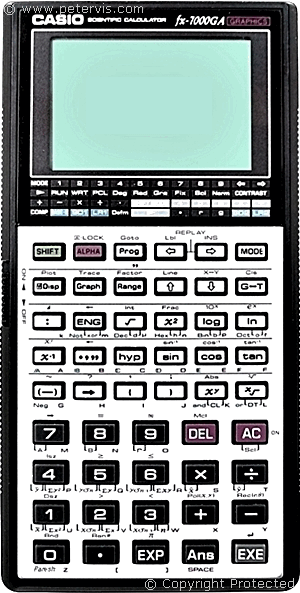Casio Fx 7000g Manual Pdf
Download manual guide of Casio Fx 8500g User Guide in pdf that we listed in Manual Guide. This ebooks file was originally from www.math.osu.edu that avaialble for FREE DOWNLOAD as owners manual, user guide / buyer guide or mechanic reference guide.
Electronic Calculators By 1961, transistors had gained a foothold in business systems. The first minicomputers had started to appear on the market, and the first fully electronic desktop calculators, the Sumlock ANITA Mk VII and Mk VIII, were introduced. Transistors were very expensive in 1961, so Sumlock opted to use miniature thyratrons as the switching elements in the ANITA. The ANITA was capable of performing addition, subtraction, multiplication and division, and used a Comptometer-style input system and Nixie tube readout. By the mid-1960s, Japan had introduced transistorized desktop calculators, and would soon be producing machines built on discrete bipolar and MOS logic.
Halid ziya ushakligilj zapretnaya lyubovj knigu in english. In 1964, a small company named Mathatronics completed development of the Mathatron, the first electronic programmable desktop calculator. Introduced more than a year before the more well-known Olivetti Programma 101, the Mathatron used full algebraic entry, complete with parentheses. The Mathatron featured an unusual 'ticker tape' style printer, whose output doubled as a single-line display. Texas Instruments foreshadowed the rapidly approaching handheld calculator market in 1967, with the announcement of the experimental 'Cal-Tech' calculator.
Like the aforementioned Mathatron, the Cal-Tech made use of ticker tape style printer which doubled as a display. Unlike the Mathatron printer, which utilized a conventional impact mechanism, the Cal-Tech's printer employed TI's new thermal printing technology. Vadivelu comedy video download.
In 1968, Hewlett-Packard introduced the 9100A, the world's first desktop programmable scientific calculator. The 9100A featured discrete diode and transistor logic, RPN entry, and used the famed CORDIC algorithm to compute transcendental functions. The success of the 9100A lead directly to the development of HP's powerful 9800-series desktop instrumentation control calculators, as well as their personal calculator product line. In 1970, MOS LSI technology became available for calculator products. Several manufacturers introduced large LSI-based handheld calculators, distinctively larger than a pocket calculator but handheld nonetheless. Sharp introduced the EL-8, based on a four-chip Rockwell chipset and Iseden Itron VFDs.
Canon introduced the Pocketronic, a commercialization of the original TI Cal-Tech design, with a three-chip TI chipset and ticker tape printer/display. In 1971, Mostek introduced the MK6010 single-chip calculator, and Bowmar entered the market with the 901B 'Brain', a truly pocket-sized handheld calculator with a TI single-chip calculator LSI and compact Bowmar Opto-Stic LED display.

Over the next two years, dozens of companies leapt into a brutal fight for dominance in an explosive new handheld calculator market, armed with LSI chipsets and single-chip calculators manufactured primarily by TI, AMI, Mostek, Rockwell and various Japanese manufacturers. In 1972, TI began in-house calculator production with the TI-2500 Datamath four-function handheld calculator. The Datamath used a TMS0110 single-chip calculator, similar to chips and small chipsets they had previously sold to other calculator vendors. Just a few months later, HP introduced the HP-35, the world's first handheld scientific calculator.
